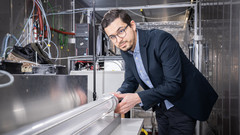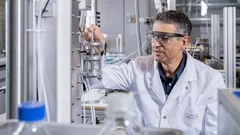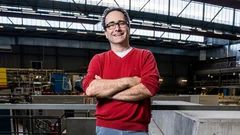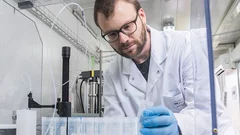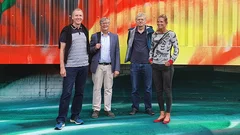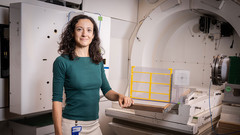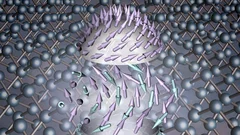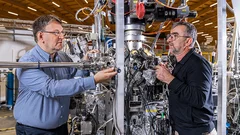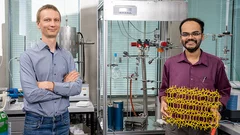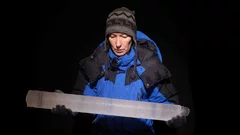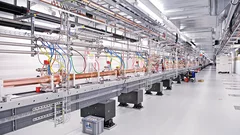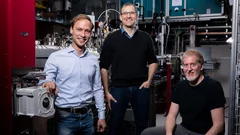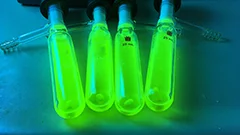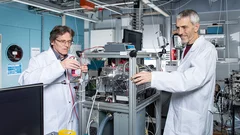Media Releases
Aerosol formation in clouds
How chemical reactions in clouds can influence the global climate.
Particulates are more dangerous than previously thought
A precise look into the finest particles in the air shows how compounds harmful to human health are formed.
Switzerland's energy transition
Can Switzerland, as planned, reduce its CO2 emissions to zero by 2050? What is needed to achieve this? What could it cost?
Green fuels for aviation
In a new initiative, PSI and Empa want to jointly develop a process for producing kerosene from renewable resources.
Size of helium nucleus measured more precisely than ever before
In experiments at the Paul Scherrer Institute PSI, an international research collaboration has measured the radius of the atomic nucleus of helium five times more precisely than ever before. The new value can be used to test fundamental physical theories.
PSI equips the Swiss Light Source SLS for the future
Green light for SLS 2.0: The planned upgrade of the Swiss Light Source SLS can proceed; the funding is provided for within the framework of the ERI Dispatch for 2021-2024, which has been approved.
Which particulate air pollution poses the greatest health risk?
The composition of particulate matter can influence its harmfulness to human health just as much as the amount, PSI researchers show in a newly published study. Experiments and computational modelling showed that in Europe high concentrations of particulate matter harmful to human health occur mainly in metropolitan areas.
A new generation of optogenetic tools for research and medicine
The European Research Council (ERC) is funding an interdisciplinary collaborative project with 10 million euros for the structural and biophysical analysis of selected photoreceptors and their development into "OptoGPCRs", light-controlled molecular switches with a wide range of applications in biology and medicine.
New technique for ultrafast tumour therapy
For the first time, researchers at the Centre for Proton Therapy at PSI have tested ultrafast, high-dose irradiation with protons. The new, experimental FLASH technique could revolutionise radiation therapy for cancer.
Nanostructures with a unique property
Researchers at the Paul Scherrer Institute PSI have for the first time identified special nano-vortices in a material: antiferromagnetic skyrmions.
Customising an electronic material
PSI scientists have investigated a material that could be suitable for future data storage applications. They have manipulated the crystalline structure of their sample while measuring how this affects the material’s magnetic and electronic properties.
Better catalysts for a sustainable bioeconomy
Zeolites are already indispensable additives in the chemical industry – researchers from PSI and ETH Zurich suggest ways to make them still more efficient.
The cold memory of the earth
Within the framework of an international project, researchers from the Paul Scherrer Institute PSI are helping to save a valuable environmental and climatic archive. During an expedition 4,000 metres above sea level on Grand Combin in the Alps, they are drilling ice cores from melting glaciers to preserve them in Antarctica.
«Forschung online erleben»: Mittendrin statt nur dabei
Erstmals Live-Rundgang durch eine Grossforschungsanlage per Video-Stream. Am 9. September haben Interessierte exklusiv die Möglichkeit, sich von Experten des PSI durch den neuen Freie-Elektronen-Röntgenlaser SwissFEL führen zu lassen und zu erfahren, welche Rätsel der Materie und der Natur sich damit lösen lassen.
Elucidating the mechanism of a light-driven sodium pump
Researchers at the Paul Scherrer Institute PSI have succeeded for the first time in recording a light-driven sodium pump from bacterial cells in action. The findings promise progress in developing new methods in neurobiology. The researchers used the new X-ray free-electron laser SwissFEL for their investigations.
Life cycle assessment of cars – new web tool helps consumers and researchers
Decision support for car buyers: Researchers at the Paul Scherrer Institute have developed a web tool called the Carculator that can be used to compare the environmental performance of passenger cars in detail.
Long-term developments of energy pricing and consumption in industry
Researchers from the Paul Scherrer Institute PSI, on behalf of a research project funded by the Swiss Federal Office of Energy (SFOE), have studied how energy consumption by Swiss industry develops depending on energy prices. One result: Price increases for energy usually affect energy consumption only over the long term.
In search of the lighting material of the future
At the Paul Scherrer Institute PSI, researchers have gained insights into a promising material for organic light-emitting diodes (OLEDs). This new understanding at the atomic level will help to develop new lighting materials that have higher light output and also are cost-efficient to manufacture.
Professor Dr. Christian Rüegg new Director of the Paul Scherrer Institute
The new director of the Paul Scherrer Institute has taken up office today. Christian Rüegg aims to further reinforce the leading role of PSI's large research facilities, and thus promote Switzerland as a location for research.
First-time direct proof of chemical reactions in particulates
Researchers at the Paul Scherrer Institute PSI have developed a new method to analyse particulate matter more precisely than ever before. With its help, they disproved an established doctrine: that molecules in aerosols undergo no further chemical transformations because they are enclosed in other particulate matter.
